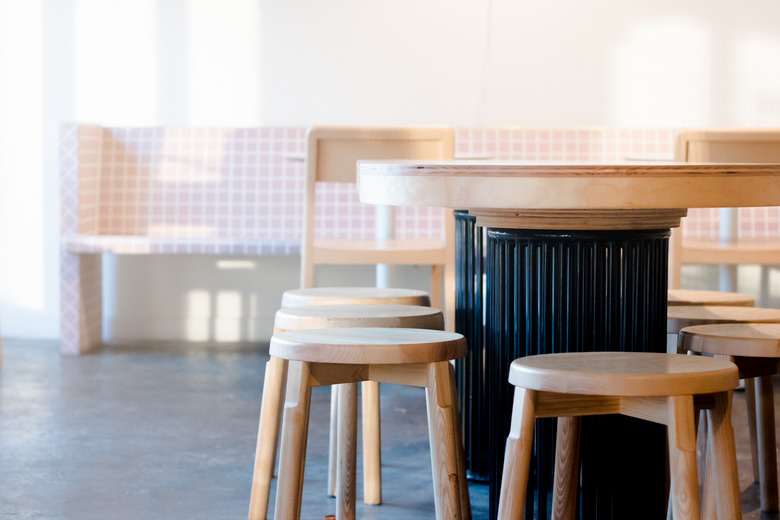Concrete Floor Repair: A Homeowner's Guide
Concrete is not a flexible material, so a concrete floor responds to temperature changes and shifting soil by cracking, and the older the floor is, the more likely it is that cracks will occur. Improperly mixed concrete can also cause cracks as well as other defects like pits and spalls that ruin the smooth surface of the floor and allow water to seep through and make the problem worse. The good news for homeowners is that a cracking, pitting or spalling concrete floor isn't that difficult to repair.
Patching Materials You Need for Concrete Floor Repair
Patching Materials You Need for Concrete Floor Repair
Many repair materials are available, and you should choose the material according to the repair you have to make. Small cracks and pits call for a smooth epoxy patching compound, but you'll want a compound with sand or aggregate for large cracks and holes, and if you decide it's a good idea to resurface the entire floor, you'll need a self-leveling resurfacing compound. It helps to know a bit about these repair products as you plan the concrete repair project.
Repairing Small Cracks and Pits
A small crack or pit is one that doesn't spread wider than about 1/4 inch. This width is too small to admit a cementitious mixture containing sand or small aggregate. Instead, you should use an epoxy, polyurethane or acrylic product that will seep into the crack to fill it. One such product is Quikrete Concrete Repair Caulk, which costs about the same as painters' caulk. The folks at All Garage Floors recommend a number of more expensive options, too, including:
- Simpson Strong-Tie Crack-Pak: This two-part epoxy filler mixes itself automatically when you apply it with a caulking gun.
- Rust-Oleum EpoxyShield Concrete Patch: This two-part epoxy filler is too thick to apply with a caulking gun, so you have to mix it yourself and apply it with a trowel.
Repairing Large Cracks, Pits and Holes
To fill large cracks and holes, you need a patching compound that more resembles the concrete itself, which can be mortar to which you can optionally add a latex flex agent to prevent cracking. Manufacturers also offer epoxy and polyurethane patching compounds designed for large holes. One such product is Xtreme Set 100. Fill the hole with sand and pour in this product, which comes as a liquid. The mixture sets harder than the concrete itself.
Resurfacing the Floor
It's sometimes easier to resurface a severely blemished floor or driveway than it is to fill the individual pits and cracks. You can use Quikrete Concrete Resurfacer or a similar product. After patching large cracks and pits, you generally mix the resurfacer to a liquid consistency, pour it on the floor and spread it with a squeegee.
Getting Ready for Concrete Floor Repairs
Getting Ready for Concrete Floor Repairs
The decision regarding whether or not to approach concrete patching as a DIY project depends on the location of the concrete surface and the quality of the results you want to achieve. An unfinished driveway, garage floor or basement floor is generally easy to repair unless appearance is critical. An indoor concrete floor is more challenging, especially if it has a finish, because the patches have to be meticulously leveled to make them unnoticeable, and that's usually a job for a pro.
Concrete slab repair can begin with patching the small cracks and pits followed by repairing the large ones and, if necessary, resurfacing. To get ready for repairs, measure pits, cracks and other damage and make a plan of attack based on the level of damage.
Next, sweep the concrete surface well and use a garden hose to wash debris out of the cracks and holes, especially the larger ones. If you have to make repairs over a wide area, it's a good idea to power wash the entire concrete surface. If you're going to use a polyurethane repair product, let the concrete dry for 24 hours because polyurethane won't cure properly in the presence of moisture.
How to Patch Small Cracks and Holes
How to Patch Small Cracks and Holes
Use an epoxy, polyurethane or acrylic filler for small repairs, being careful to read the directions on the container for the proper mixing and application method. If you have to mix the product yourself, check the open time on the container (the time that the product is spreadable) so you don't mix too much.
- With a wire brush, clean out the cracks and holes you're about to fill and then use a broom to brush away any dust that comes out.
- Apply the filler with a caulking gun or trowel or pour it (depending on the product), filling the crevice completely. It's a good idea to overfill slightly to be sure. If the crevice is deep, you may need two applications separated by 24 hours because some products sink slightly before they set.
- Scrape the repair with a trowel to level the patching compound.
- Let the product set for eight hours before walking on the surface. If you use a polyurethane product, protect it from rain for 24 hours while it cures.
How to Patch Large Cracks and Holes
How to Patch Large Cracks and Holes
Before patching larger cracks and holes, it's important to remove loose material from the edges to ensure the patching compound adheres to a solid surface. It's also a good idea to apply a bonding agent such as Quikrete Liquid Fortifier to strengthen the concrete.
- Chisel all loose material from the sides of the crack or hole with a cold chisel and a hammer. If you're using a mortar-based patching compound, it's a good idea to undercut the edges of the crevice with the chisel to prevent the patch from lifting out.
- Clean the crevice with a wire brush and pour in the bonding agent. If the area is large, you can apply the bonding agent with a paintbrush.
- Mix the patching compound according to the directions and fill the crevice using a trowel to spread the compound evenly.
- Wait for the compound to lose its watery sheen. Trowel the repair flat and give it eight to 24 hours to harden.
How to Resurface a Concrete Slab
How to Resurface a Concrete Slab
Resurfacing is a way to hide any cracks and pits that you've patched, and it's also a good way to smooth a concrete surface that is severely spalled. Before you begin, check for an existing seal coat by pouring water on the concrete and noting whether or not it beads up. If it does, remove the sealer with chemical stripper. If you don't do this, the resurfacing material won't adhere.
- Power wash the surface to remove grease and oil that will prevent adhesion.
- Use duct tape to seal any expansion joints (control joints) to keep the resurfacing compound out of the joints. If the pad transitions to another type of flooring, glue weatherstripping to the floor at the transition line to prevent the compound from spilling over.
- Mix the resurfacing compound to a pourable consistency following the instructions on the container.
- Pour the compound on the floor and spread it with a large squeegee on a long handle. The liquid will seek its own level, so all you have to do is make sure that it's smooth and that it covers the floor evenly and completely.
- Create a slip-resistant surface if desired by running a push broom over the resurfacing compound after it stiffens but before it hardens.


